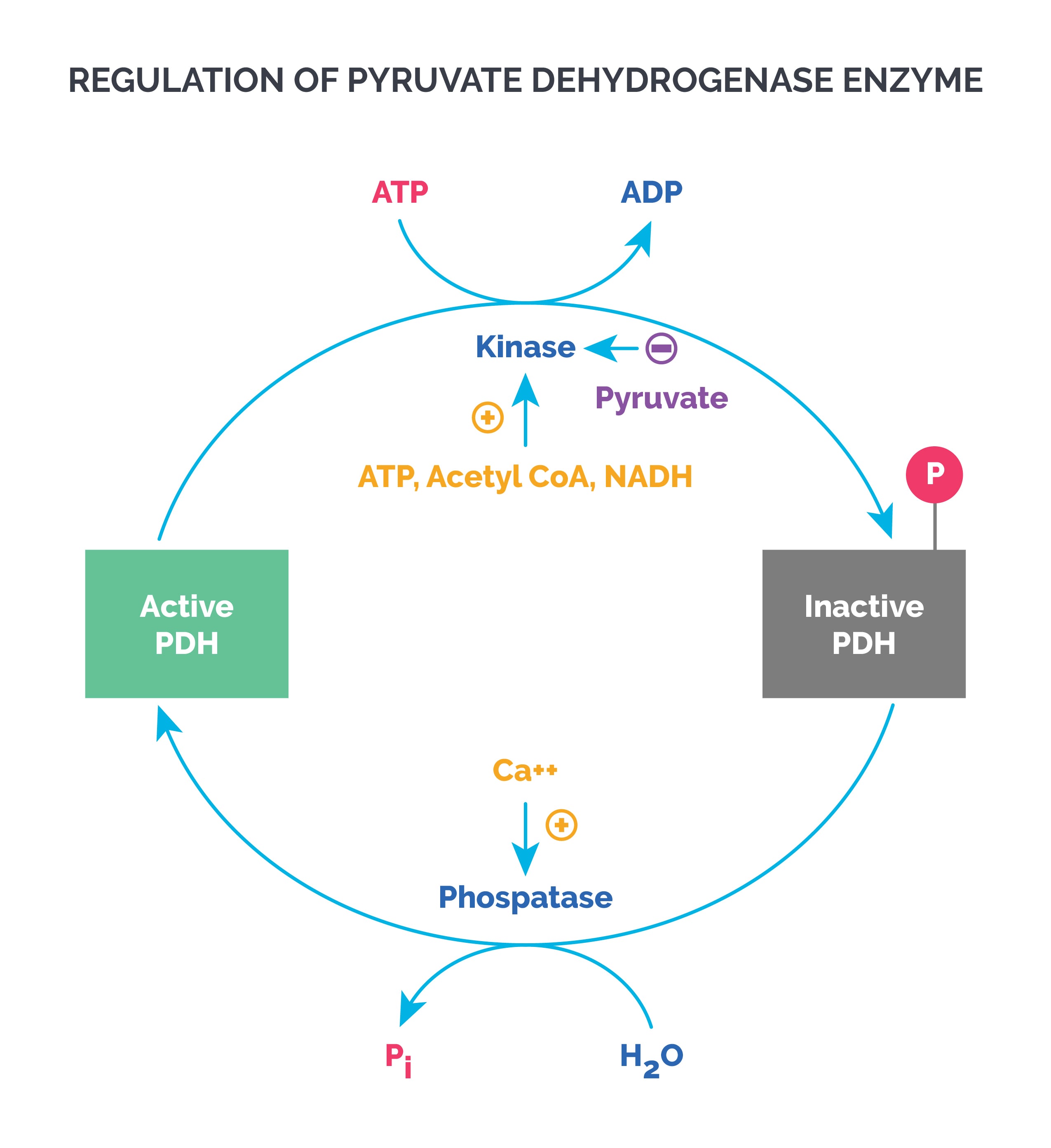It is the final pathway where the oxidative metabolism of carbs, fats and amino acids converge, their carbon skeletons being converted to CO2. The cycle occurs totally in the mitochondria. It also provides intermediates for many synthetic reactions like glucose formation from the carbon skeletons of some amino acids and provision of building blocks for some amino acids and heme.
Oxidative Decarboxylation of Pyruvate: Pyruvate, the end product of aerobic glycolysis, must be transported into the mitochondria before it can enter the TCA cycle. This is done by a specific pyruvate transporter that helps it to cross the inner mitochondrial membrane. Once in the mitochondrial matrix, pyruvate is converted to acetyl CoA by the multienzyme complex of Pyruvate Dehydrogenase. The complex has two tightly bound regulatory enzymes PDH Kinase and PDH Phosphatase. There are five Coenzymes for PDH – thiamine pyrophosphate (TPP), lipoic Acid, CoA, FAD and NAD. They act as carriers or oxidants.
Thiamine /Niacin Deficiency: PDH unable to function, ATP supply via TCA cycle limited, CNS affected more commonly e.g. Wernicke- Korsakoff Psychosis in alcoholics results from thiamine deficiency.
Regulation of PDH: PDH Kinase phosphorylates and inactivates PDH while PDH Phosphatase activates PDH. The Kinase is allosterically activated by ATP, Acetyl CoA and NADH (inhibiting PDH). Pyruvate is a potent inhibitor of Pyruvate Kinase (activates PDH). Calcium is an activator of Pyruvate Phosphatase (activates PDH). Remember that TCA cycle enzymes, just like glycolysis are active when dephosphorylated.

PDH Deficiency: Causes congenital lactic acidosis. CNS effects like neurodegeneration, muscle spasticity, early neonatal death. X Linked dominant so affects both males and females as the enzyme is so vital to life. Leigh’s Syndrome of subacute necrotizing encephalomyelopathy due to defects in mitochondrial ATP production mainly due to mutations in the PDH complex, ETC or ATP Synthase enzyme. Both nuclear and mitochondrial DNA may be involved.
Arsenic Poisoning: Apart from interfering with glycolysis, arsenic also inhibits enzymes which require lipoic acid as a coenzyme such as PDH, alpha ketoglutarate dehydrogenase and branched chain alpha keto acid dehydrogenase. Arsenite (trivalent arsenic) forms a stable complex with thiol (-SH) groups in lipoic acid and inhibits the enzyme. Pyruvate and lactate accumulate affecting the brain more commonly, and causing death.
The TCA cycle occurs in the following steps:
Oxaloacetate combines with Acetyl CoA to form Citrate (a tricarboxylic acid) by Citrate Synthase. Citrate inhibits PFK 1 of glycolysis while activating Acetyl CoA Carboxylase of fatty acid synthesis.
Citrate is isomerized to Isocitrate by enzyme Aconitase, an Fe-S protein. Aconitase is inhibited by Fluoroacetate in rat poison.
Isocitrate is converted to Alpha ketoglutarate by Isocitrate Dehydrogenase yielding 3 NADH. It is a rate limiting step of the TCA cycle. The enzyme is allosterically activated by ADP and Calcium and is inhibited by ATP and NADH.
Alpha keto Glutarate is converted to Succinyl CoA by enzyme complex alpha ketoglutarate dehydrogenase. It has 5 coenzymes TPP, CoA, Lipoic Acid, FAD and NAD. The enzyme is inhibited by succinyl CoA, NADH and activated by calcium. Transamination of amino acids glutamate yields alpha ketoglutarate.
Succinyl CoA is cleaved to succinate by enzyme succinate thiokinase (also called succinyl CoA synthase). It is a substrate level phosphorylation yielding 1 GTP. Succinyl CoA is also produced from propionyl CoA from metabolism of odd chain fatty acids and also from some amino acids.
Succinate is oxidized to fumarate by succinate dehydrogenase. FADH2 is formed. This enzyme functions as Complex II of the ETC.
Fumarate is hydrated to malate by fumarate hydratase. Fumarate is also produced in urea Cycle, purine synthesis and during the catabolism of amino acids phenylalanine and tyrosine.
Malate is oxidized to oxaloacetate by malate dehydrogenase. NADH is also produced. Oxaloacetate is also produced by the transamination of aspartic acid.
Energy Yield in TCA Cycle: For each molecule of Acetyl CoA that enters the cycle, 3 NADH, 1 FADH2 and 1 GTP is produced. 1 NADH yields 3 ATP while 1 FADH2 yields 2 ATP, while 1 GTP gives 1 ATP. So in all, 12 ATP are produced just by TCA cycle per molecule of Acetyl CoA oxidized. Note that 1 molecule of glucose yields 2 molecules of Acetyl CoA, hence 24 ATP by TCA cycle. Depending on which shuttle is used by NADH to re-enter the mitochondrial matrix, 2 ATP are produced using glycerol phosphate and 3 ATP are produced using malate-aspartate shuttle.
Sign up for free to take 2 quiz questions on this topic